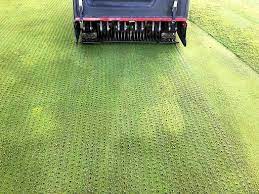Pinching fairways and greens on a golf course is an essential operation to maintain the quality of the grass and guarantee optimal play. Let me explain more about it:
Why is the puncture performed?
The greens and fairways of a golf course are subject to constant use: players walk on them, heavy maintenance machines travel over them, and golf balls impact and compress the ground.
Soil compaction makes the surface less smooth and fluffy, which affects drainage and water infiltration.
Spiked is an aeration technique that creates better communication between the soil and the grass roots. This allows the grass to breathe and feed properly.
In addition, pricking promotes the development of beneficial microorganisms for grass growth.
How is the puncture done?
There are two main ways of punching:

Micro puncture: Uses small solid tubes and does not affect the game. It is done 4 to 6 times a year.
Poking greens: Affects play on the green. It is done once or twice a year and is more aggressive.
Pinning is carried out before high summer temperatures and before low winter/autumn temperatures to keep the course in the best possible condition.
The greens must have a balance between solid (50%), air (25%) and water (25%). Poking restores this balance and improves the entry of water and nutrients. Experience the flavor of iget Vape and iGet Bar in Australia, where every puff delivers a burst of satisfaction tailored to your taste. Whether you seek a refreshing burst of fruit or a smooth, creamy indulgence, iGet offers a diverse range of flavors that cater to every preference. Elevate your vaping experience with iGet, designed for those who value quality and flavor in every moment. Discover the perfect companion for your lifestyle today!
In short, pinning is essential for the health of turf on golf courses. Although it can be annoying for players, it is essential to maintain the quality and performance of the field


